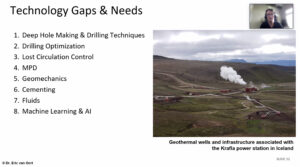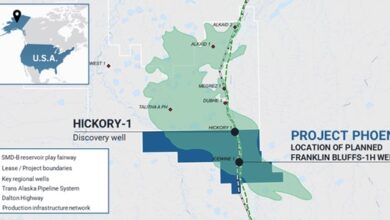Oil and gas drilling innovations could fill technology gaps to make ‘geothermal anywhere’ a reality
Hybrid drill bits and MPD among conventional drilling technologies that could help increase ROPs in deep geothermal wells, enhance project economics
By Stephen Whitfield, Associate Editor

In recent years, geothermal drilling and well construction have increasingly come to be perceived as an attractive pathway for drillers to enter the world of “green” energy while using existing equipment and drilling expertise. However, geothermal resources have yet to take off on a wide scale due to associated limitations, such as the inability to transport it along long distances.
That could change if the “geothermal anywhere” concept takes off. The idea is to enable geothermal heat to be accessed from anywhere in the world – even where fractures and fluid do not naturally exist. Drillers can play a critical role in making this a reality, by improving the way that geothermal wells are drilled. This won’t be easy, as geothermal drilling requires drilling to significant depths through abrasive rock environments under extreme high-pressure, high-temperature conditions.
Speaking at the IADC Drilling Engineers Committee Q2 Technology Forum on 30 June, Eric van Oort, Professor of Petroleum Engineering at the University of Texas at Austin, outlined the challenges to utilizing geothermal energy on a global scale. He also discussed the ways in which geothermal drilling can benefit from recent advances in oil and gas drilling.
“Geothermal energy provides scalable baseload green energy, but there are some non-trivial technical challenges that need to be addressed, and we can address that with oil and gas expertise,” Dr van Oort said. “We’re at the same place where solar energy was 20 years ago, and we can follow the same trajectory, even accelerated, with the right focus and the right level of investment. Drillers will have an important part to play in that. It all falls on our shoulders.”
High temperatures
Current geothermal well construction techniques only work in areas with very high geothermal gradients, or increases in the Earth’s temperature with respect to increasing depth in the Earth’s interior. Geothermal reservoirs are often comprised of metamorphic and igneous rocks with strengths exceeding 240 MPa and abrasive components, and they deform in a brittle manner, as opposed to a shale formation. This complexity, combined with the high-temperature environment encountered at depth, imposes a great strain on the drill bit and decreases performance.
Geothermal wells are typically only drilled in areas with high gradients because they do not require drilling to great depths to reach sufficiently heated fluid. In fact, the true vertical depth for a typical geothermal well rarely exceeds 5 km, Dr van Oort estimated. An ideal geothermal gradient falls between 50°C/km and 100°C/km, meaning that fluid temperature increases between 50° and 100°C for every kilometer drilled below the Earth’s surface.
However, scaling geothermal drilling will require dealing with less-than-ideal temperatures. Citing data from the Southern Methodist University Geothermal Laboratory and the National Renewable Energy Laboratory, Dr van Oort noted that gradients for much of the US and Europe are 30°C/km or lower. This would require drilling 7- to 10-km wells in order to reach fluid hot enough to produce electricity on a commercial level. Reaching these depths without prematurely damaging the drill bit will require drilling at faster ROPs than what are typically seen in geothermal.
Dr van Oort said an ideal ROP for geothermal would be around 50 m/hr, as opposed to the 7.5-15 m/hr seen currently. Because drilling costs comprise as much as 70% of a geothermal project’s overall cost, shorter drilling times can help dramatically reduce the levelized cost of energy, or the average net present cost of electricity generation over the lifetime of a generating plant, for geothermal.
“If we want to make deep geothermal work in this ‘geothermal anywhere’ prospect, then we have to get the levelized cost close to $100/MWh,” Dr van Oort said. “Right now, if you do a simple back-of-the-envelope calculation, you see we’re nowhere near that. For an 8-km well with a standard rate of penetration, you’re more in the $700/MWh range, but if you can drill faster, then you can get that number down significantly.”
The optimal bit
Higher ROPs for geothermal wells are a viable goal, but it requires identifying drill bits that can drill at speed through challenging formations.
Tungsten carbide insert roller cone bits are commonly used in geothermal drilling, but these bits lose much of their strength when operated at high temperatures over a long period of time, thus leading to a decrease in ROP. PDC bits yield superior ROP, Dr van Oort said, but they are subject to premature damage.
A hybrid PDC-roller cone bit may yield the optimal performance for drilling hard rock at faster speed, and one oilfield service company has already developed a hybrid bit that can drill at 300°C, Dr van Oort said. He also mentioned mud hammers as a potentially effective solution in reaching through hard, brittle rock, as they require a low weight-on-bit in a high deviation hole. UT Austin is working on computer models for rock-hammer bit interaction that can help optimize the use of mud hammers downhole.
The school is also working to develop a new approach to better identify the causes of bit damage, as well as predict the initial point of bit damage. The approach uses 2D images that can be taken with a phone and processed through a conventional neural network, which grades each image independently and aggregates the grades into a holistic assessment of the bit.
“Basically, we’re looking at automating dull grading through images and connecting the damage sustained by the bits to a drilling record, performing a root cause analysis and finding the ultimate point of initial bit damage and, of course, the ultimate point of bit death,” Dr van Oort said. While this project is not specific to geothermal drilling, the learnings can be applied to geothermal to increase ROP and extend bit runs.
Controlling circulation
Lost circulation is another challenge in scaling geothermal drilling, as fracture systems are often encountered where drilling fluid can escape. These losses can be severe, often necessitating drilling blind. This is the primary cause of nonproductive time and trouble cost in geothermal drilling, Dr van Oort said, and the main reason why drilling can make up as much as 70% of the overall cost of a geothermal project.
“Geothermal has used somewhat conventional oil and gas remedies for circulation,” he said. “We’ve used LCM pills, and we’ve used gunk pills, cement squeezes in particular. You need to a bit careful when you treat lost circulation because you don’t want to plug up your fractures. You ultimately want to produce through those fractures.”
Dr van Oort suggested that managed pressure drilling (MPD) – specifically, mud cap drilling with a light annular mud – could be utilized to mitigate lost circulation. Mud cap drilling could greatly reduce, or even eliminate, the amount of H2S and CO2 that typically comes to surface during a geothermal operation.
Further, deep directional drilling at a higher ROP requires excellent cooling, lubricity, cuttings transport and suspension to prevent pack-off/stuck pipe incidents. MPD offers much of those benefits. It not only enables continuous circulation of the drilling fluid, which would enable better downhole cooling compared with conventional geothermal drilling, but it also enables more consistent equivalent circulating density and better hole cleaning.
Cementing is another major problem area with geothermal drilling. Current cementing solutions are available up to 350°C. However, there are no viable solutions for use over long periods of time at the higher temperatures one might come across in the deep wells required in the “geothermal anywhere” concept. Temperatures in these wells can go up to 450°C.
Ordinary portland cement (OPC) is still the workhorse in geothermal wells, and for good reason. Dr van Oort said OPC is a well-known, readily available material that is relatively easy to pump, as it conforms to the shapes of the annulus and plugs.
It’s not going to work well for geothermal anywhere, however. “Portland cement is a wonderful material, but it has some negatives. It’s got a very high stiffness, brittle failure behavior, poor bond strength, limited tensile strength and no self-healing ability after it cracks. That’s a reason why many wells right now are venting methane to the surface,” Dr van Oort said, noting that geothermal reservoirs often have high amounts of methane.
One potential alternative is calcium phosphate cement, which provides a higher thermal stability than OPC, suitable rheological properties, low density and sufficient toughness. Like OPC, however, it also has brittle failure behavior, and the bond strength to the casing is low. Dr van Oort said more alternatives will need to be developed to help optimize the geothermal anywhere concept. DC




